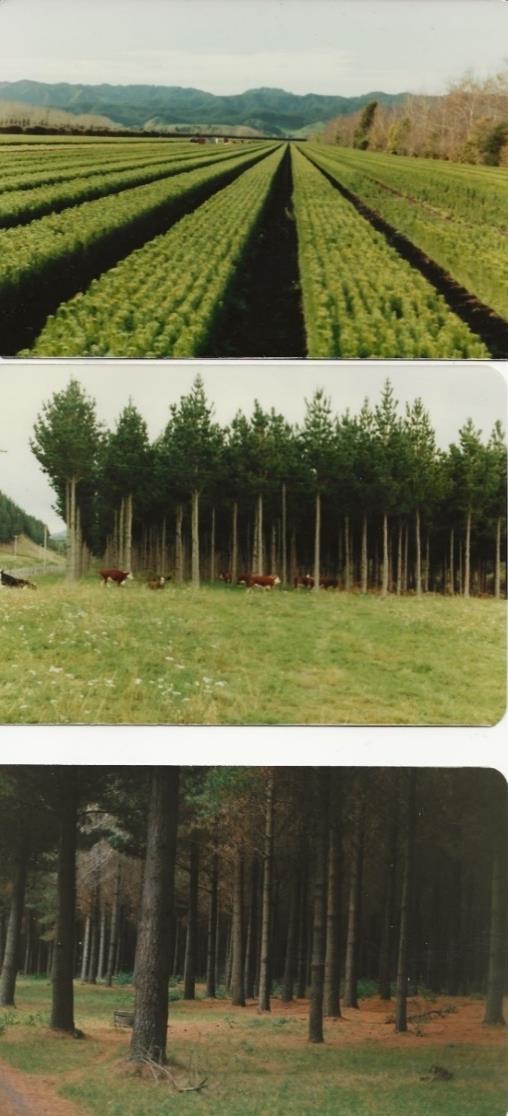
2 minute read
New Zealand
from PNGAF MAGAZINE ISSUE # 9D4D of 15th March 2022 - global timeline forest tree plantations
by rbmccarthy
tannin has declined relative to the value of the wood, which makes good charcoal and excellent paper pulp.
In the Indian subcontinent many pioneering developments in tropical silviculture took place and, as early as 1912, Broun30 described in detail afforestation and plantation practice. Indeed, India’s tree planting programmes were well in advance of those of the then colonial power, the UK.
Advertisement
However in most tropical countries forest plantations were still in their infancy, though many silvicultural developments took place that were later to feature strongly, most notable of which were: the introduction of the taungya system in many tropical countries; species and provenance trials; the development of the famous and revolutionary thinning schedules by Craib31 (1934, 1947) in South Africa, which has so impacted plantation silviculture elsewhere; enrichment planting to supplement inadequate natural regeneration; and ‘compensatory plantations’ to augment local wood supplies as areas of natural forest declined.
Arguably, the best early example was the 4000 ha of E. globulus planted between 1900 and 1920 on the amphitheatre of hills around Addis Ababa, Ethiopia, which made up for the loss of indigenous forest in the previous decade, providing a sustained supply of fuel for the city to this day.
In New Zealand, the first Māori in New Zealand cleared vast areas of land for hunting, then came the European settlers who burned and harvested forests to create farms, ships, and buildings.
Radiata pine (Pinus radiata, Monterey Pine, New Zealand Pine), seed was imported from California in the 1840s to grow animal shelter belts. Despite laws to encourage tree planting, mass forest clearance was so rapid that by 1913, some indigenous species faced imminent
30 Broun, A. F. 1912. Sylviculture in the tropics. London: Macmillan and Co. 31 Craib, I. J., (1931) The Place of Thinning in Wattle Silviculture and Its Bearing on the Management of Exotic Conifer. Zeitschrift für Weltforstwirtshaft, 1 (1931), 77–108. Craib I J (1939) Thinning, pruning and management studies on the main exotic conifers grown in South Africa. Union Sc. Africa Dept. Agr and forestry Sci, Bul 196,179 pp illus. Craib I J (1947) The silviculture of exotic conifers. British Empire Forestry Conference 35 pp. illus. City Printing Works Ltd. Pietermaritzburg South Africa.
extinction. In 1918 timber exports were restricted, and in 1925 the Government introduced financial incentives to create plantations of imported species and reduce the pressure on native forests.

The economic depression in the late 1920’s stimulated massive plantings of P. radiata in Australia and New Zealand. Resulting mass plantings in the 1920s and 1930s, and again in the 1960s, created a robust exotic plantation forestry industry that was soon able to supply all New Zealand’s domestic timber needs and secure the future of the remaining natural forest. Today, one third of the world’s total radiata pine stock is found in New Zealand.
P. radiata planted 1910 Dunedin NZ. Howard Heath NZ Forestry and Dick McCarthy.
Tasman Nursery Te Teki NZ. * year old Pradiata cuttings Tasman NZ. P. radiata 25 years old Rotura. 250 stems/ha looking into 400 stems/ha. Photo credit Dick McCarthy 1990.
Prior to 1925, Pinus pinaster from Europe and P. radiata from California dominated plantings in South Africa but after 1935, Mexican pine P. patula and P. elliottii from southern USA were favoured.








